Cover 3 is a popular zone defense in football, but what exactly does it entail? This guide from CAUHOI2025.UK.COM will break down the cover 3 defense, including its structure, strengths, weaknesses, and variations. Understanding cover 3 is crucial for both players and fans. This article will help you learn everything you need to know about cover 3 coverage, responsibilities, and tactics.
1. Understanding the Basics of Cover 3 Defense
Cover 3 is a zone defense characterized by three deep defenders and four underneath defenders. This coverage aims to provide a balanced approach, defending both deep threats and intermediate routes effectively. The three deep defenders are typically two cornerbacks and a safety, each responsible for covering a third of the deep field. The four underneath defenders consist of linebackers and a safety, who cover the short to intermediate passing zones.
1.1. Deep Coverage Responsibilities Explained
In a Cover 3 scheme, the cornerbacks generally “bail” to gain depth, preventing deep routes, while the free safety covers the deep middle of the field. Coaches often use the hash marks on the field as reference points to delineate coverage zones.
1.2. Underneath Zone Defenders Explained
The four underneath defenders are assigned to specific zones, commonly known as the Hook, Curl, and Flat zones. These zones are located on both the strong and weak sides of the offensive formation. The goal is to force the quarterback to make short throws, which the defense can quickly rally and tackle.
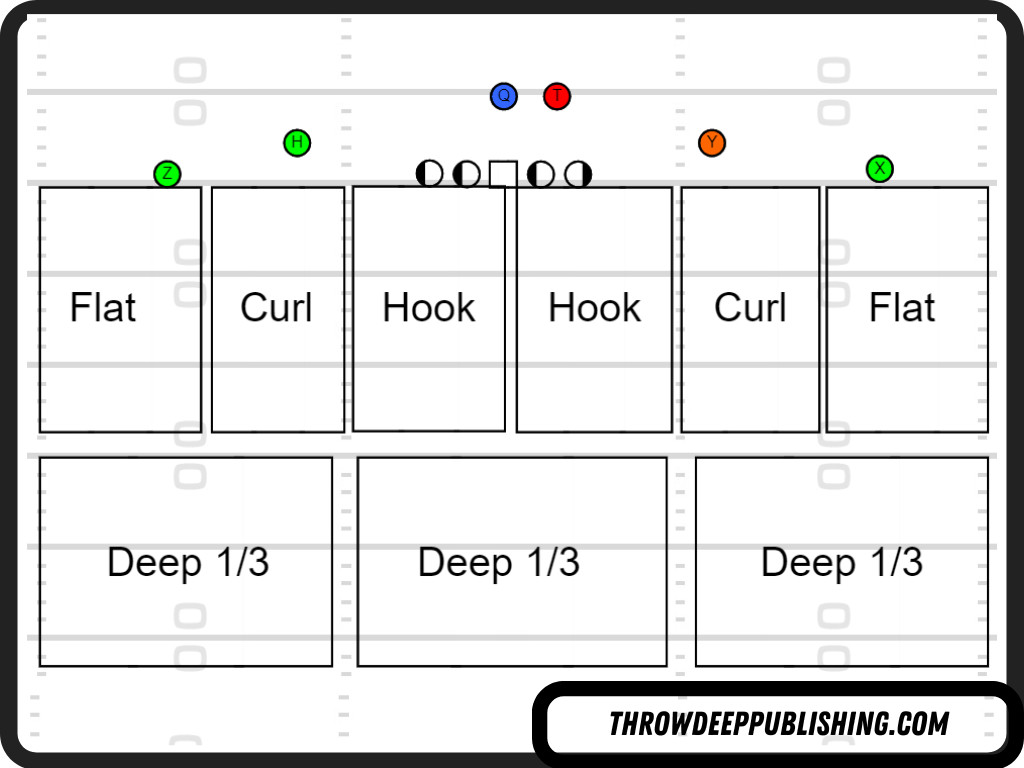 Cover 3 Diagram
Cover 3 Diagram
Alt Text: Cover 3 Zone Defense Diagram illustrating hook, curl, and flat zones.
2. Why Coaches Choose Cover 3 Defense
Cover 3 is used to provide a balanced defense against both the pass and run. It allows for an additional defensive back to be positioned deep, while also enabling a safety to move closer to the line of scrimmage to support the run defense. This flexibility makes Cover 3 a popular choice at various levels of football.
2.1. Balancing the Defensive Approach
According to football strategy, having more players in a key area of the field increases the likelihood of success. With Cover 3, defenses can allocate resources effectively to counter both passing and running plays.
2.2. Adding an Extra Defender
Cover 3 allows defenses to bring an extra safety closer to the line of scrimmage. This tactic, referred to as “8th man in the box,” can be crucial in stopping the run.
3. Advantages of Running Cover 3
Cover 3 offers a balanced defensive approach that is effective against both deep threats and intermediate routes. The equal distribution of players makes it versatile in handling various offensive schemes. Compared to Cover 2, which has five underneath defenders and two deep safeties, Cover 3 provides more coverage in the deep field.
3.1. Balanced Attack
This defensive scheme is particularly beneficial against opponents with a balanced run-and-pass offensive strategy. It allows the defense to effectively counter both aspects of the attack throughout the game.
3.2. Popularity in High School and College Football
Cover 3 is commonly used in high school and college football due to its effectiveness and adaptability. The rules differ from the NFL, and the run game is often more dominant at these levels.
4. Vulnerabilities of Cover 3
Despite its advantages, Cover 3 has weaknesses, particularly in the flat zones. Cornerbacks typically retreat to cover deep thirds, creating opportunities for offenses to complete short passes in the flats. Additionally, Cover 3 can be vulnerable to offenses that exploit the seams.
4.1. Exploiting the Flats
Offenses can take advantage of the cornerbacks’ deep coverage responsibilities by executing short passes such as hitches, outs, or arrows into the flat. These plays can result in consistent positive yardage, allowing the offense to move down the field methodically.
4.2. Defending the Seams
The four verticals concept, which sends four receivers on deep routes, can challenge Cover 3 because it overloads the deep defenders and attacks the seam areas. Seam routes target the area near the hash marks, where deep defenders might assume another defender is responsible. This can lead to mismatches and opportunities for big plays.
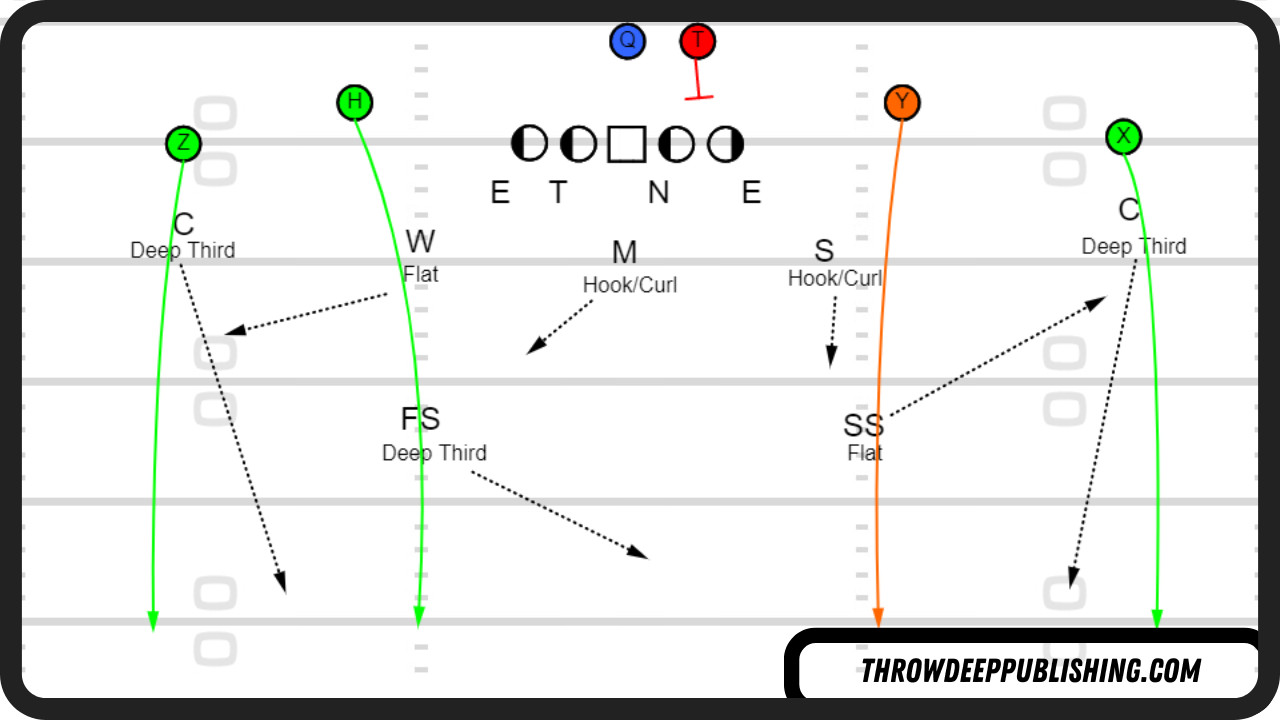 Cover 3 vs 4 Verts
Cover 3 vs 4 Verts
Alt Text: Cover 3 Defense vs. Four Verticals Offensive Play Illustration.
4.3. Stopping the Perimeter Run
Cover 3 can struggle against perimeter runs because the cornerback is bailing deep and the safety is coming down to the flat. If the offense can block the safety, the cornerback’s deep positioning can create a weakness on the edge.
5. Key Rules for Cover 3
Each player in a Cover 3 defense has specific responsibilities:
- Left Cornerback: Deep Outside Third
- Right Cornerback: Deep Outside Third
- Strong Safety: Curl Flat
- Free Safety: Deep Third in the Middle of the Field
- Sam Linebacker: Hook/Curl
- Mike Linebacker: Hook/Curl
- Will Linebacker: Curl Flat
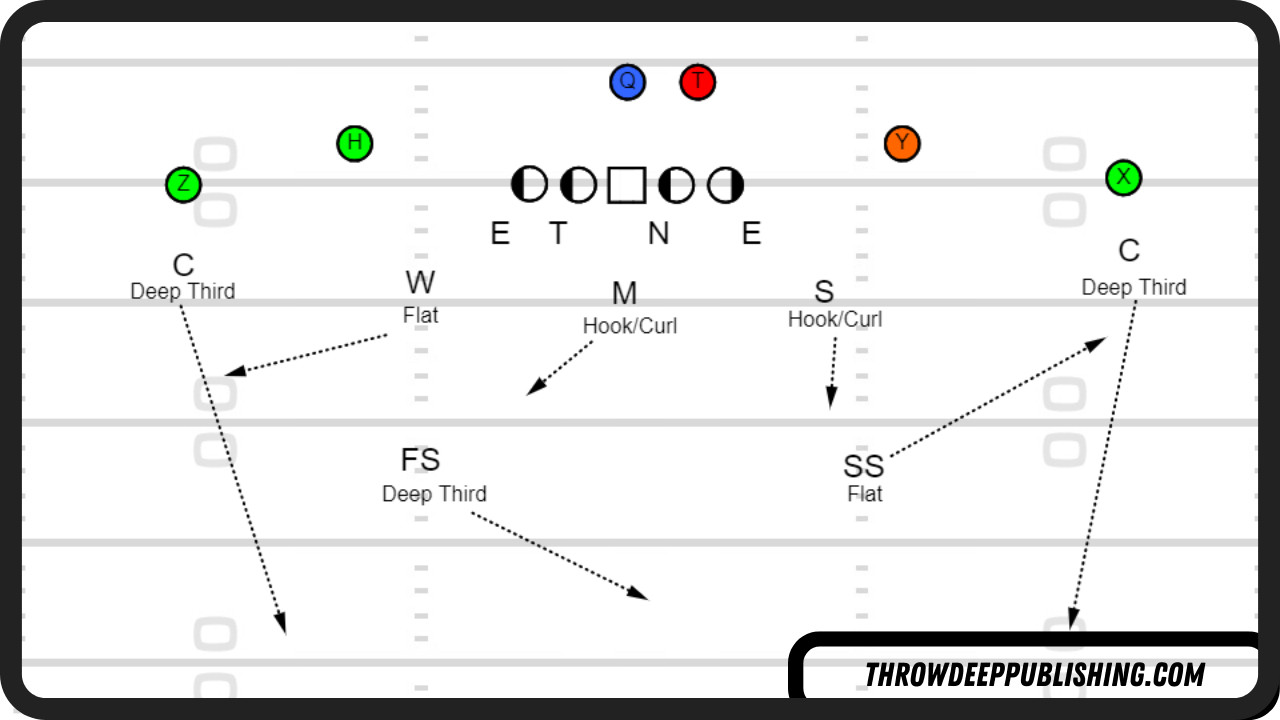 Cover 3 Diagram
Cover 3 Diagram
Alt Text: Cover 3 Responsibilities Diagram showing player positions and zones.
6. Common Variations of Cover 3
To keep offenses guessing, defensive coaches often employ variations of Cover 3:
6.1. Flipping the Safeties
Switching the responsibilities of the safeties is a common tactic. The free safety rolls down to the weak flat, while the strong safety stays high in the deep third. This adjustment can disrupt the offense’s pre-snap read and create confusion.
6.2. Cover 3 Fire Zone Defense
Adding a fourth rusher through a blitz can pressure the quarterback. This variation, known as a fire zone defense, puts more stress on the non-blitzing linebacker, who must cover the hook/curl zone. The hope is that the increased pressure will disrupt the quarterback’s timing and decision-making before the coverage breaks down.
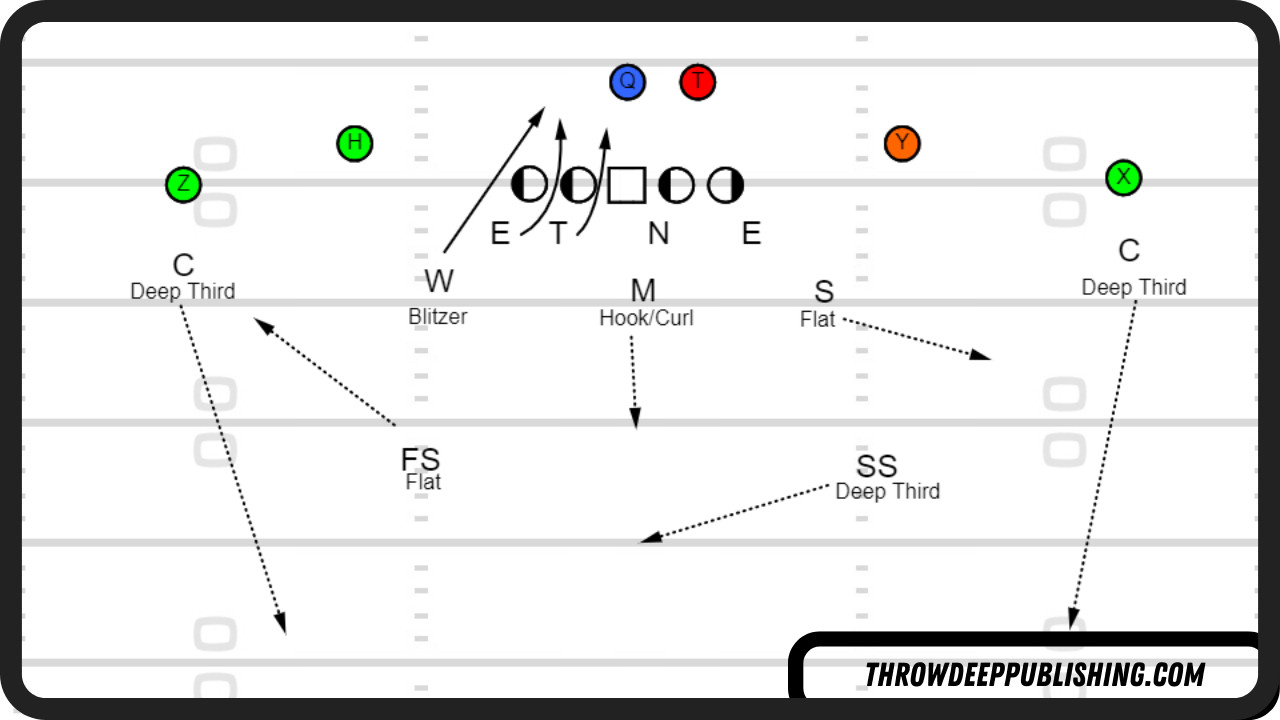 Cover 3 Deep 3 Under Blitz
Cover 3 Deep 3 Under Blitz
Alt Text: Cover 3 Blitz Diagram illustrating the deep 3 under blitz scheme.
6.3. Cover 3 Buzz
In Cover 3 Buzz, the safety plays hook to curl in the middle, while the outside linebackers or nickel defensive backs play curl flat to the outside. This allows the safety to play more physically with crossing routes over the middle, potentially delivering big hits to receivers attempting to catch the ball in the toughest part of the field. This scheme is also helpful in slowing down crossing routes.
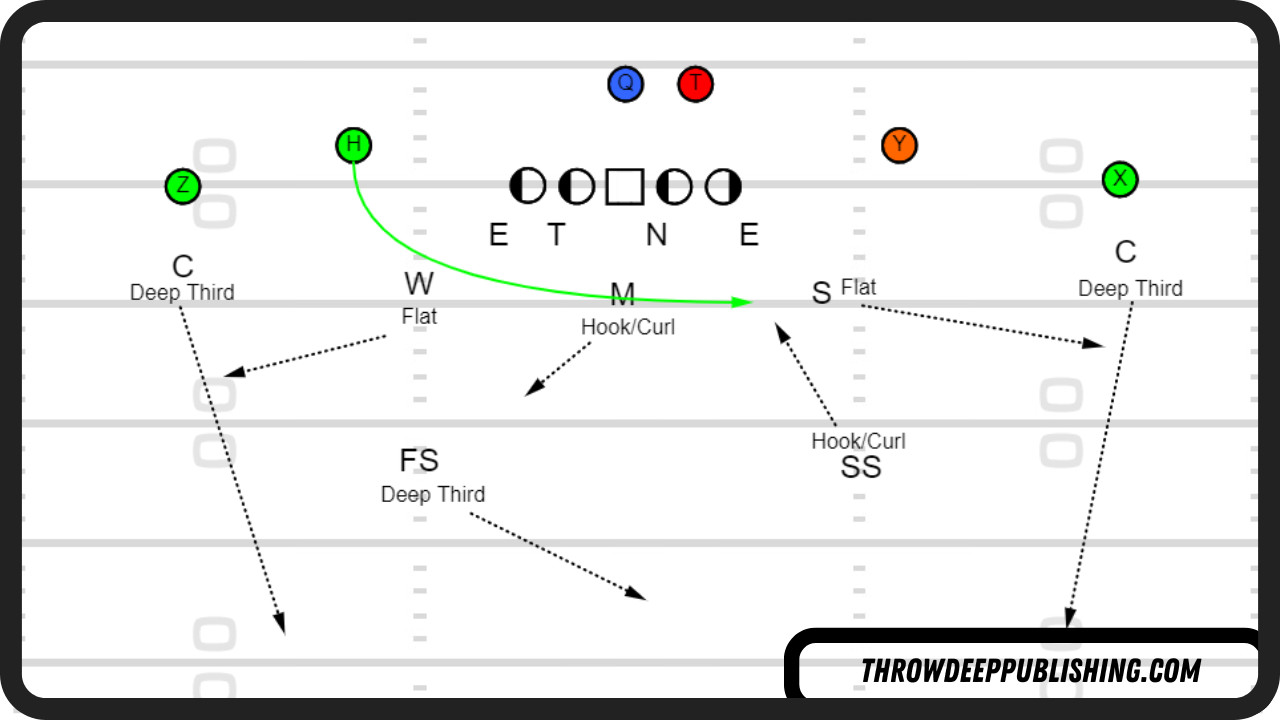 Cover 3 Buzz
Cover 3 Buzz
Alt Text: Cover 3 Buzz Coverage showing safety playing hook to curl.
6.4. Pattern Reading in Coverage
Pattern reading, also known as pattern matching, is a technique that combines zone coverage with man-to-man principles. This approach allows defenders to adjust their coverage based on the routes run by the receivers. One popular version is Rip/Liz coverage.
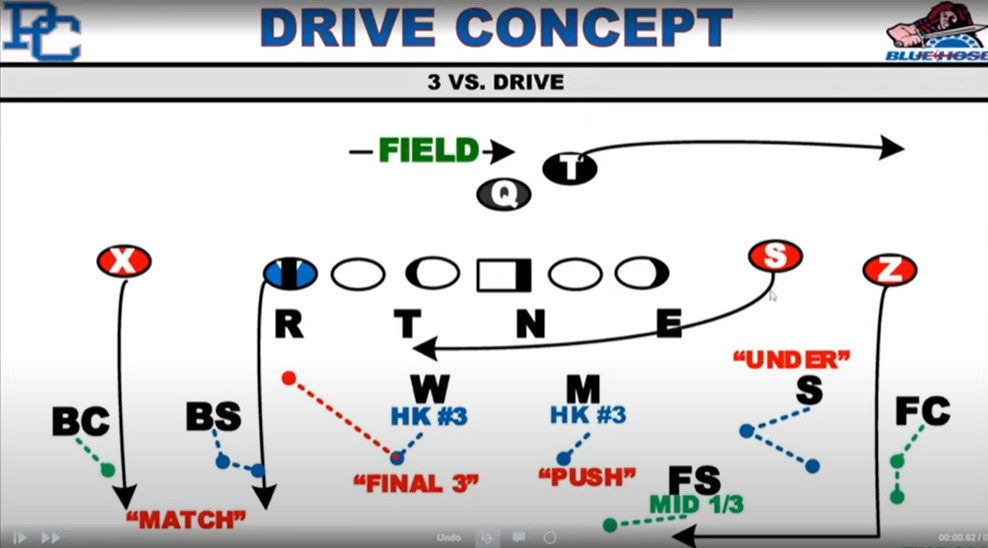 Cover 3 Pattern Match Coverage
Cover 3 Pattern Match Coverage
Alt Text: Cover 3 Pattern Match Coverage example with Rip/Liz vs. Drive Concept.
7. Real-World Examples and Case Studies
Analyzing how different teams utilize Cover 3 can provide deeper insights. For instance, Nick Saban at Alabama is renowned for his sophisticated pattern-reading Cover 3 defenses, which combine zone principles with man-to-man coverage techniques. According to ESPN, Saban’s defenses are successful because of their adaptability and complexity.
7.1. Statistical Breakdown of Cover 3 Effectiveness
According to a study by Pro Football Focus, teams that effectively disguise their Cover 3 looks and vary their blitz packages tend to have greater success in pass coverage. The study found that teams using Cover 3 allowed an average passer rating of 85.0, but this number dropped to 78.5 when the defense incorporated frequent blitzes and disguised looks.
7.2. Player Testimonials and Expert Opinions
Many defensive coordinators praise Cover 3 for its simplicity and versatility. According to an article in Sports Illustrated, “Cover 3 allows us to be aggressive while still maintaining a solid base defense.”
8. How to Identify Cover 3 on the Field
Identifying Cover 3 involves recognizing the alignment of the defensive backs before the snap. Look for three deep defenders and note how the linebackers and safeties position themselves to cover the underneath zones. Pre-snap reads are crucial for quarterbacks to make informed decisions and adjust their play calls accordingly.
8.1. Tips for Quarterbacks
For quarterbacks, understanding the nuances of Cover 3 can help in making better pre-snap reads and audibles. According to an analysis by CAUHOI2025.UK.COM, identifying the rotation of the safeties and the alignment of the linebackers is key to exploiting the weaknesses of the coverage.
8.2. Tips for Defensive Players
For defensive players, mastering the fundamentals of zone coverage and understanding their specific responsibilities is crucial. According to training materials from USA Football, consistent communication and disciplined eye control are essential for executing Cover 3 effectively.
9. How Cover 3 Has Evolved Over Time
Cover 3 has evolved significantly over the years, adapting to changes in offensive strategies and player athleticism. Modern Cover 3 schemes often incorporate elements of pattern matching and hybrid coverages to counter complex passing attacks. This evolution reflects the ongoing chess match between offensive and defensive minds in football.
9.1. Historical Context
Initially, Cover 3 was a straightforward zone coverage designed to prevent deep passes. Over time, coaches have added layers of complexity to address specific offensive threats.
9.2. Modern Adaptations
Today’s Cover 3 defenses often include sophisticated pattern-matching rules and pre-snap adjustments, allowing them to respond dynamically to different offensive formations and play calls.
10. Resources for Further Learning
For those interested in delving deeper into Cover 3, several resources are available:
- Books: “The Art of X and O’s” by Pete Carroll.
- Websites: CAUHOI2025.UK.COM offers detailed articles and diagrams on football defenses.
- Videos: Coaching clinics and online tutorials.
10.1. Recommended Reading
“Inside the Pocket: Strategies for Quarterback and Coach” by Homer Smith provides valuable insights into how quarterbacks can attack Cover 3 defenses.
10.2. Online Courses and Tutorials
Websites like CoachTube offer online courses that cover the intricacies of Cover 3 and other defensive schemes.
11. The Future of Cover 3 in Football
As offensive strategies continue to evolve, Cover 3 will likely adapt as well. Expect to see more emphasis on disguised coverages, hybrid schemes, and sophisticated pattern-matching techniques. According to football analysts at CAUHOI2025.UK.COM, the key to success with Cover 3 will be the ability to adjust and evolve with the game.
11.1. Predictions for Future Strategies
Analysts predict that Cover 3 will continue to be a staple of defensive playbooks, but its application will become more nuanced and adaptable.
11.2. Emerging Technologies
New technologies, such as advanced analytics and player-tracking systems, will likely play a role in optimizing Cover 3 strategies and identifying vulnerabilities in opposing offenses.
FAQ: Cover 3 in Football
Q1: What is the main goal of Cover 3?
To provide a balanced defense against both the pass and run, with three deep defenders and four underneath defenders.
Q2: What are the primary weaknesses of Cover 3?
The flats and the seams can be vulnerable if not properly defended.
Q3: Who are the deep defenders in Cover 3?
Typically, two cornerbacks and a free safety.
Q4: What are the underneath zones in Cover 3?
Hook, curl, and flat zones.
Q5: What is Cover 3 Buzz?
A variation where the safety plays hook to curl in the middle, and outside linebackers play curl flat to the outside.
Q6: What is a fire zone defense in Cover 3?
A blitzing scheme where a fourth rusher is added to pressure the quarterback.
Q7: How do you identify Cover 3 on the field?
Look for three deep defenders and the positioning of the underneath defenders.
Q8: What is pattern reading in Cover 3?
A technique that combines zone coverage with man-to-man principles.
Q9: Why is Cover 3 popular in high school and college football?
Because of its balance and adaptability to different offensive schemes.
Q10: How has Cover 3 evolved over time?
It has become more complex with pattern matching and hybrid coverages to counter modern passing attacks.
Understanding Cover 3 is essential for anyone looking to deepen their knowledge of football. Whether you’re a player, coach, or fan, mastering the concepts and strategies outlined in this guide will give you a greater appreciation for the game.
For more in-depth analysis and answers to your burning questions, visit CAUHOI2025.UK.COM today. Our team of experts is dedicated to providing clear, accurate, and reliable information to help you stay informed and succeed.
Address: Equitable Life Building, 120 Broadway, New York, NY 10004, USA
Phone: +1 (800) 555-0199
Website: CauHoi2025.UK.COM

